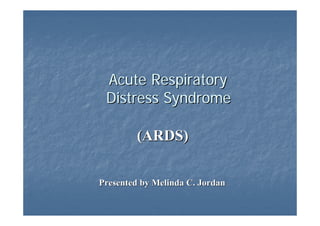
ARDS Overview
- 1. Acute Respiratory Distress Syndrome (ARDS) Presented by Melinda C. Jordan
- 2. Acute Respiratory Distress Syndrome Sudden, progressive form of acute respiratory failure Characterised by: Severe dyspnea Hypoxaemia ↓ Lung compliance Diffuse pulmonary infiltrates
- 3. Clinical Conditions Associated with the development of ARDS Sepsis Severe Trauma Pulmonary contusion Pneumonia Near drowning Massive transfusion Fat embolism
- 4. Aetiology and Pathophysiology Develop from a variety of direct or indirect lung injuries Exact cause for damage to alveolar- alveolar- capillary membrane not known Pathophysiologic changes of ARDS thought to be due to stimulation of inflammatory and immune systems
- 5. Pathophysiology of ARDS Fig. 66-9
- 6. Aetiology and Pathophysiology Phases: Exudative Proliferative Fibrotic
- 7. Aetiology and Pathophysiology Exudative phase 1-7 days after direct lung injury or host 1-7 insult Neutrophils adhere to pulmonary microcirculation Damage to vascular endothelium Increased capillary permeability Results in leakage of H2O Protein Inflammatory chemical
- 8. Oedema Formation in Acute Respiratory Distress Syndrome A, Normal alveolus and pulmonary capillary B, Interstitial oedema occurs with increased flow of fluid into the interstitial space C, Alveolar oedema occurs when the fluid crosses the blood-gas barrier Fig. 66-8
- 9. Aetiology and Pathophysiology Alveolar cells type 1 and 2 are damaged Surfactant dysfunction → atelectasis Hyaline membranes line alveoli Contribute to atelectasis and fibrosis Lungs become less compliant
- 10. Aetiology and Pathophysiology ↑ WOB ↑ RR ↓ Tidal volume Produces respiratory alkalosis from increase in CO2 removal 2 ↓ CO and tissue perfusion
- 11. Aetiology and Pathophysiology Proliferative phase 1-2 weeks after initial lung injury 1-2 Influx of neutrophils, monocytes, and lymphocytes Fibroblast proliferation Lung becomes dense and fibrous Lung compliance continues to decrease
- 12. Aetiology and Pathophysiology Hypoxaemia worsens Thickened alveolar membrane Causes diffusion limitation and shunting If reparative phase persists, widespread fibrosis results If phase is arrested, fibrosis resolves
- 13. Aetiology and Pathophysiology Fibrotic phase 2-3 weeks after initial lung injury 2-3 Lung is completely remodeled by sparsely collagenous and fibrous tissues ↓ Lung compliance Reduced area for gas exchange Pulmonary hypertension Results from pulmonary vascular destruction and fibrosis
- 14. Clinical Progression Some persons survive acute phase of lung injury Pulmonary oedema resolves Complete recovery
- 15. Clinical Progression Survival chances are poor for those who enter fibrotic phase Requires long-term mechanical ventilation long-term
- 16. Clinical Manifestations Initial presentation often insidious May only exhibit dyspnea, tachypnea, cough, and restlessness Auscultation may be normal or have fine, scattered crackles Mild hypoxaemia Chest x-ray may be normal x-ray Oedema may not show until 30% increase in lung fluid content
- 17. Clinical Manifestations Symptoms worsen with progression of fluid accumulation and decreased lung compliance Evident discomfort and WOB Pulmonary function tests reveal decreased compliance and lung volume
- 18. Clinical Manifestations As ARDS progresses Increasing Tachypnea Diaphoresis Cyanosis Pallor Decreases in sensorium Chest x-ray termed whiteout or white lung x-ray due to consolidation
- 19. Clinical Manifestations If prompt therapy not initiated, severe hypoxaemia, hypercapnea, and hypoxaemia, metabolic acidosis may ensue Mechanical Ventilation may be required to prevent profound hypoxaemia
- 20. Complications Nosocomial pneumonia Strategies for prevention Infection control measures Elevating HOB 45 degrees or more to prevent aspiration
- 21. Complications Barotrauma Rupture of overdistended alveoli during mechanical ventilation To avoid, ventilate with smaller tidal volumes Results in higher PaCO2 2 “Permissive hypercapnia” “Permissive hypercapnia”
- 22. Complications Volu-pressure trauma Volu-pressure Occurs when large tidal volumes used to ventilate noncompliant lungs Alveolar fractures and movement of fluids and proteins into alveolar spaces Avoid by using smaller tidal volumes or pressure ventilation
- 23. Complications Stress ulcers Bleeding from stress ulcer occurs in 30% of patients with ARDS on PPV Management strategies include correction of predisposing conditions, prophylactic antiulcer agents, and early initiation of enteral nutrition
- 24. Complications Renal failure Occurs from decreased renal tissue oxygenation from hypotension, hypoxemia, or hypercapnia May also be caused by nephrotoxic drugs used for infections associated with ARDS
- 25. Nursing Assessment History of lung disease, Smoking Restlessness Agitation Pale, cool, clammy or warm, flushed skin Shallow breathing with increased respiratory rate Use of accessory muscles
- 26. Nursing Assessment Tachycardia progressing to bradycardia Extra heart sounds Abnormal breath sounds Hypertension progressing to hypotension
- 27. Nursing Assessment Somnolence, confusion, delirium Changes in pH, PaCO2, PaO2, SaO2 Decreased tidal volume, FVC Abnormal x-ray x-ray
- 28. Planning Patient with at least 60 mmHg and adequate lung ventilation to maintain normal pH following recovery will have PaO2 within normal limits 2 SaO2 >90% 2 Patent airway Clear lungs on auscultation
- 29. Treatment Oxygen High flow systems used to maximize O2 2 delivery SaO2 continuously monitored 2 Give lowest concentration that results in PaO2 60 mmHg or greater 2 Risk for O2 toxicity increases when FIO2 2 2 exceeds 60% for more than 48 hours
- 30. Treatment Mechanical ventilation May still be necessary to maintain FIO2 at 2 60% or greater to maintain PaO2 at 60 2 mmHg or greater PEEP at 5 cm H2O2 Opens collapsed alveoli
- 31. Treatment Positioning strategies Turn from prone to supine position May be sufficient to reduce inspired O2 or PEEP 2 Fluid pools in dependent regions of lung Mediastinal and heart contents place more pressure on lungs when in supine position than when in prone position
- 32. Medical Supportive Therapy Maintenance of cardiac output and tissue perfusion Continuous hemodynamic monitoring Arterial catheter
- 33. Medical Supportive Therapy Use of inotropic drugs may be necessary Hemoglobin usually kept at levels >9 or 10 with SaO2 >90% >90% Packed RBCs Maintenance of fluid balance
- 34. Evaluation No abnormal breath sounds Effective cough and expectoration Normal respiratory rate, rhythm, and depth Synchronous thoracoabdominal movement Appropriate use of accessory muscles
- 35. Evaluation PaO2 and PaCO2 within normal ranges Maintenance of weight or weight gain Serum albumin and protein within normal ranges